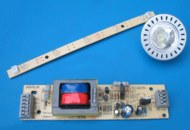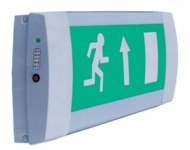Reducing the cost burden of emergency lighting

Ventilux constant-power LED Module for emergency luminaires. This makes use of energy-efficient LED lighting and cadmium-free nickel metal hydride (NiMH) batteries.
Light-emitting diodes (LEDs) are well suited to emergency lighting. Barrie Walsh explains how their efficient use of electricity and long life can reduced the cost burden of emergency lighting.There is a growing awareness among building operators and facilities managers that the cumulative operating costs of emergency lighting can be considerable, especially in premises such as hotels and hospitals that make extensive use of maintained emergency lighting (in which the lamps are in operation at all material times.) Maintained emergency lighting is not only costly in terms of energy usage but also maintenance costs. Full compliance with the inspection and testing requirements of the emergency lighting code of practice, BS 5266-1, imposes a further cost burden. However, significant economies can be achieved in all of these areas.
LED lighting There is considerable interest in the benefits of light-emitting-diode (LED) lighting in emergency and general-purpose lighting applications, but the characteristics and benefits are not fully understood by many specifiers and developers.
 |
Emergency luminaire with Autotest facility which carries out daily checks and monthly, six-monthly and annual discharge tests. |
A typical emergency luminaire with LED lighting uses a strip of 10 low-voltage light-emitting diodes supplied directly from a battery. In contrast, a traditional emergency luminaire uses a single inverter-fed 8 W tubular fluorescent lamp. The price of LED lighting is becoming increasingly competitive. Light-emitting diodes consume about 25% of the power of the equivalent tubular fluorescent lamps. They offer excellent lumen maintenance compared with the fluorescent equivalent, so the light output from a luminaire will remain consistent through life. The colour characteristics of LEDs have improved dramatically. Further, the uniformity of lighting achieved by an array of 10 LEDs is much better than that of an 8 W fluorescent tube, especially in edge-lit signs. This means that the luminosity requirements of British and European standards are more readily, and consistently, achieved with LED lighting.
 |
The Netcom 5XP addressable centralised test system is suitable for use with up to 25 300 luminaires. It uses a standard personal computer and a ‘node’ in each luminaire. |
A major cost benefit with LED lighting relates to lamp replacement. The rated life of a tubular fluorescent lamp is 5000 h. This means that with maintained lighting, lamps will need replacing every seven months. In contrast the rated life of LED lamps is 50 000 h (5.7 years). This means that the slightly higher cost of LED lighting will be recovered in seven months! In addition LED lamp replacement can be timed to coincide with battery replacement (normally every four years). The actual cost and disruption involved in lamp replacement must also be factored into these considerations. The labour costs involved in lamp replacement can be far higher than the cost of the lamps themselves. In some applications (e.g. factories or medical environments) normal activity may have to stop during lamp replacement. This may have an effect on productivity or may involve major procedural changes. Unscheduled lamp replacement due to premature failure of tubular fluorescent lamps can be even more costly and disruptive. Premature failure of one lamp in a display of 10 LEDs will have no such effect and may not even be noticed. Environmental considerations cannot be ignored. Tubular fluorescent lamps contain mercury and are subject to the WEEE and RoHS Directives. Light-emitting diodes do not contain any mercury and are much easier to dispose of at the end of life.
Batteries Lamps are not the only component affecting cost in emergency lighting. Nickel-cadmium (NiCd) batteries have long been the preferred choice for self-contained luminaires. Their use is so well established that emergency lighting is excluded from European requirements regulating the use of cadmium — a highly toxic metal. Any environmentally-concerned body should be looking for more sustainable alternatives. The nickel metal hydride (NiMH) battery is a viable alternative that offers significant benefits over the NiCd battery. It is similar in many respects, including operating voltage, but offers an energy density two to three times that of the NiCd battery. This means that the battery can be a third the size of the NiCd equivalent. Combined with an LED light source and the appropriate charger, a very compact package is possible. Environmentally the NiMH battery is cadmium-free, and the high energy density means that the volume of active material is much lower than NiCd. The battery uses a hydrogen-absorbing alloy, rather than cadmium, as the anode material and a nickel cathode. Another significant benefit of the NiMH battery for emergency lighting is the charging regime. Nickel-cadmium batteries require a constant current charge. This results in a standing load of 3 to 4 VA, with associated heating effect. In contrast, NiMH batteries have an excellent rapid-charge characteristic; this means they can be given a boost charge followed by a trickle charge. This represents further energy savings in a large installation of emergency luminaires. Ventilux has just introduced a constant-power LED module for self-contained luminaires which reaps the benefits of all these features by combining an NiMH battery, LED lighting and a purpose-designed charger module. This is already used in the company’s Stylex and Glade self-contained emergency luminaires; it can also be incorporated into any manufacturer’s luminaires to achieve excellent life-cycle costs. The constant power discharge ensures constant illumination over a 3 h discharge.
Testing A third major area for cost savings is in testing. BS 5266-1, the code of practice for emergency lighting, calls for daily, monthly, half yearly and annual checks as follows. • Daily: Check that the charge indicator is lit on all emergency luminaires and check the lamps on all maintained luminaries to confirm that they are working.
• Monthly: Perform an operational test for a short period (maximum 25% of rated duration).
• Six monthly: Test for at least a third of the rated duration of the system.
• Annually: Carry out a full duration test.
 |
The award-winning Netcom 5XP system will monitor over 2000 self-contained and central battery fed emergency luminaires in the Paradise Project in Liverpool. (Image courtesy of Grosvenor.) |
Future European regulations could call for a full discharge test every month. Manual testing therefor, involves running the emergency lighting back-up system for the appropriate time for the monthly, half yearly and annual tests and physically walking round a site and looking at every luminaire to ensure that it is working. This is labour-intensive, intrusive and expensive. In many cases it will be neglected. Automatic testing systems are now available and can offer payback within months. These range from simple stand-alone test modules incorporated in self-contained luminaires to centralised automatic testing systems. Stand-alone units like Ventilux’ Autotest will automatically carry out the daily check as well as monthly, half-yearly and annual tests specified in BS 5266-1 and provide visual indication of the condition of lamp, battery and charger/inverter. It can provide an audible alarm. The most comprehensive centralised system is Ventilux’s Netcom 5XP system, winner of the Health & Safety Initiative of the Year Award in the UK Electrical Industry Awards 2007. This uses addressable self-test modules in every luminaire, communicating via an Ethernet system with a central control panel comprising a standard personal computer and Windows-based software. The system is scalable for use with anything from 100 to 25 300 self-contained or central-battery-fed luminaires. It carries out all the BS 5266-1 tests (or other tests if required), alerting the operator to any luminaires requiring attention. The operator can interrogate individual luminaires for current status and historic data on each luminaire in the system. The system can interface with BMS and other systems.
Conclusion Emergency lighting represents a significant cost in any modern building, both in terms of total energy costs and maintenance. However, modern technology means that major costs savings can be achieved right across the board.
Barrie Walsh is managing director with Ventilux UK Ltd, Unit 20, Britonwood Trading Estate, Knowsley Industrial Estate, Kirkby, Merseyside L33 7UT.
Related links:











